Back to: size
Forward to: head
Colour
Adults of very small Polydesmida usually have no, or very little pigmentation. They appear to be white or a very pale yellow (image below). Early juveniles of surface-dwelling species, and adults of cave-dwelling species (of all sizes) are also usually colourless.
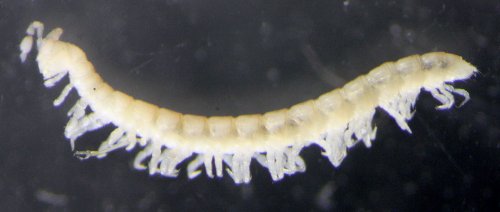
Setoisenoton pallidus (Dalodesmidae), Tasmania
About 5 mm long
Most adult Polydesmida are coloured, often beautifully. Besides displaying a very large range of colours, Polydesmida can also be patterned in many ways — with longitudinal stripes, transverse bands, and spots and patches of different shapes and sizes.
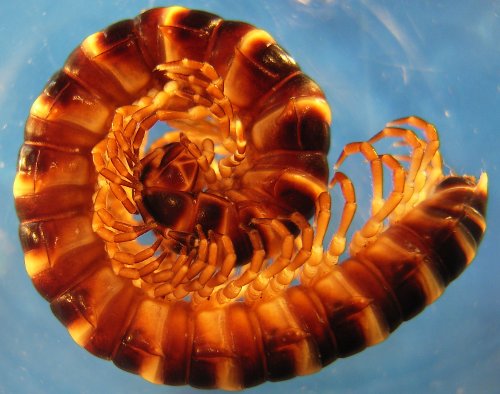
Hoplatessara pugiona (Paradoxosomatidae), Victoria, Australia
About 40 mm long
Colours and patterns fade gradually over the years in alcohol in a museum jar, and some Polydesmida have unstable pigmentation, which changes rapidly after the specimen is preserved (example below). It is good practice to record the colours and patterns of living animals whenever possible, in words or with colour photography.
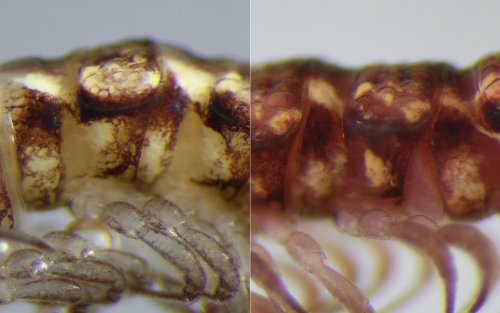
Tasmaniosoma fasciculum (Dalodesmidae), Tasmania
Left: Freshly collected, in very dilute alcohol
Right: The same specimen after 6 hours in 80% alcohol
Unfortunately, people often describe the same colour using different words. One person's dark red might be another person's maroon. Further, while there are many, many colour words, some of them have broad meanings. Dictionary definitions of fulvous, for example, include dull yellow, dull yellow with a mixture of gray and brown, dull reddish yellow, dull brownish yellow and tawny.
Although there are colour standard schemes which can be used to match specimen colours with words or codes, no one scheme has been adopted by Polydesmida specialists. Most describers do the best they can with words like yellowish brown or pale reddish.
A minor problem is that it often takes some time for body colour to develop after a moult. The three images below all show mature males of Somethus tasmani (Paradoxosomatidae) from Tasmania. Fresh from its last moult, a male is uniformly very pale yellow (not shown). Over the next few weeks, the male's colour gradually darkens to a deep reddish brown.

Colours and patterns are not always useful for identifying a species. In a nicely illustrated study, Paul Marek and Jason Bond (2009) showed that Polydesmida in the Appalachian mountains in the USA form a mimicry ring, where a number of unrelated species share the same bright, warning colour patterns. This excellent paper is freely available online. See the image below for an example of this mimicry; these two species were found at the same site.
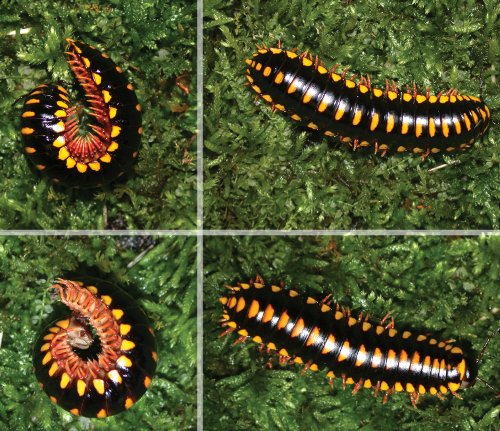
Top (left and right): Apheloria sp. (Xystodesmidae)
Bottom (left and right): Brachoria mendota (Xystodesmidae)
Images courtesy Paul Marek
Finally, no discussion of millipede colour could be complete without a mention of Thailand's 'shocking pink' millipede, shown in the image below (left). This polydesmidan enjoyed worldwide celebrity when it was declared one of the 'top 10 species of 2008' by the International Institute for Species Exploration. Pink is also in fashion in Peru (below, right).
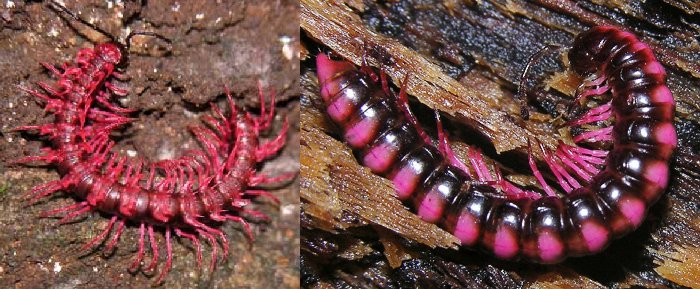
Left: Desmoxytes purpurosea (Paradoxosomatidae)
Image copyright 2007 by Somsak Panha; used with permission
Right: Unidentified polydesmidan, Peruvian Amazon
Image copyright 2008 by Arthur Anker; used with permission
Marek, P.E. and Bond, J.E. 2009. A Müllerian mimicry ring in Appalachian millipedes. Proceedings of the National Academy of Sciences (USA) 109(24): 9755–9760.
Back to: size
Forward to: head
